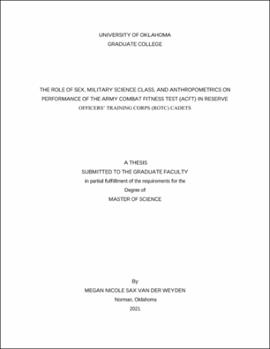| dc.description.abstract | The Army Combat Fitness Test (ACFT) was created to better assess all realms of physical fitness on an age and sex-neutral scale. Despite an increasing number of females joining the more physically rigorous military occupational specialties, to date, no published research has analyzed how female soldiers score on the sex-neutral ACFT compared to male soldiers. Similarly, no research has analyzed how military experience plays a role in ACFT performance nor how body anthropometrics may affect ACFT outcomes. Lastly, no research has been presented analyzing how effective a semester of military physical training is at eliciting performance gains on the ACFT. PURPOSE: The main purpose of this study was to identify if and where sex-based and experience-based differences exist and to identify possible relationships between anthropometric variables and ACFT outcomes in ROTC cadets. An additional aim of this study was to analyze if a semester of physical training is an adequate stimulus to elicit ACFT performance improvements and to determine significant predictors that put a cadet at more or less risk to fail or score in a particular qualification category. METHODS: Retrospective ACFT scores, military experience, and anthropometric data were used from 20 universities within Cadet Command’s 5th BDE. Each university’s ROTC program conducted the ACFT at the end of the semester per published protocol and reported the de-identified results. Analysis was conducted using SPSS (SPSS Inc., Chicago, IL, version 26.0) and statistical significance was set at p ≤ 0.05. RESULTS: Male cadets performed significantly better than female cadets on all ACFT events, in total ACFT score, and in average qualification category. MS-3 and MS-4 (upperclassmen) cadets tended to outperform their underclassmen counterparts and scored statistically better than MS-1 (freshmen) cadets on the standing power throw (SPT), sprint-drag-carry (SDC), two-mile run (2MR), total points scored, and average qualification level. Height, mass, and BMI were significantly correlated with ACFT outcomes. Moderate correlations (> 0.5) were observed between height and the three-repetition maximum dead lift (MDL), SPT, SDC, and total points. Moderate correlations were also observed between mass and MDL, SPT, and SDC. All other correlations were significant but weak. When separated by sex, anthropometric values were significantly, but less strongly correlated to ACFT outcomes. A semester of physical training was able to elicit performance gains with male cadets significantly improving their MDL, SDC, 2MR, total points, and qualification category outcomes and female cadets significantly improving their SDC, LT, SPT, total points, and qualification category outcomes. Lastly, multinomial logistic regression determined sex, height, body mass, and military experience to be significant predictors in ACFT qualification categories for individual events and total outcomes. CONCLUSION: Males performed significantly better on the ACFT than females and cadets tend to increase their overall fitness each year they are enrolled in the ROTC program. Based on these, pre- and post-semester, and anthropometric results, additional resistance training to increase strength, power, anaerobic capacity, and muscle mass may be beneficial for female and MS-1 cadets. | en_US |
